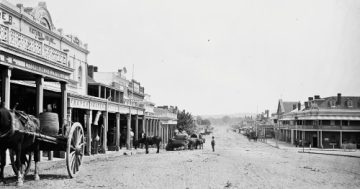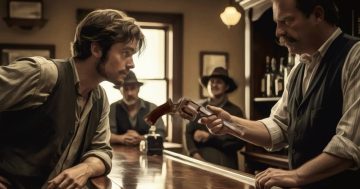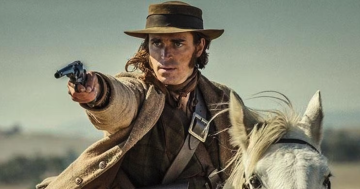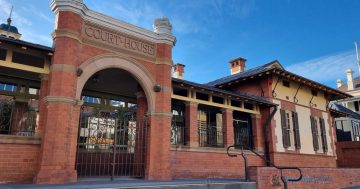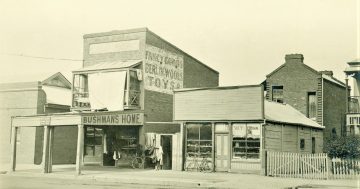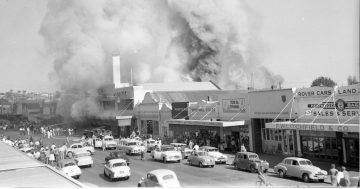
Henry Baylis and the bullet that almost killed him. It appears on a fob chain in the portrait. Photo: Museum of the Riverina and Chris Roe.
One of the more curious pieces in the Museum of the Riverina’s collection is the bullet that shattered the thumb and passed through the shoulder of Henry Baylis.
The man Wagga’s main street is named after was a Scottish-born law clerk who, in 1858 at the age of 32, became the settlement’s first police magistrate.
As well as taking a leading hand in the development of the Wagga community, Baylis famously traded shots with the notorious bushranger Dan “Mad Dog” Morgan.
In August 1863, Baylis was on his way to Urana when Morgan and his accomplice, known as both ”German Bill” and ”Flash Clarke”, blocked his path.
“Stand or I’ll blow your bloody head off!” called out a tall man brandishing a shotgun.
“Blow away,” replied Baylis, taking advantage of the fact that the bushrangers had dismounted to make a break for it on his own horse.
The pair fired at the magistrate before retrieving their mounts to give chase.
Baylis struggled to keep his seat as he crashed through the brush and trees with the outlaws hot on his tail.
Sensing a big payday, the bushrangers spurred on their superior mounts to overtake the magistrate and ordered him at gunpoint to “pull up”.
Baylis remained defiant but handed over £4 and his watch under threat of death.

”Morgan the Bushranger”, an 1864 woodblock print by Samuel Calvert.
Morgan was apparently impressed by Baylis’s courage and was curious as to why he had risked being shot for such a paltry sum.
Upon learning that Baylis was a magistrate, the unpredictable outlaw returned his property and attempted to strike a deal, declaring: “If we come before you, I hope you’ll be easy with us.”
But Baylis was having none of it and assured them that he would “do his duty” if they were to meet again.
Days later, Baylis had joined police in hunting for the pair and they soon found their empty camp in a hut on Brookong Creek between Lockhart and Urana.
As they waited into the evening for the outlaws to return, rain forced the police to shelter in the hut to keep their weapons dry.
They soon heard something moving towards them in the dark through the bush and Baylis assured his companions that it was not a possum and “was a man’s step”.
Borrowing a pistol from a constable, he headed outside where he was fired upon almost immediately.
The shot missed and he called on the retreating figure of Clarke to “surrender” as he took aim with the revolver.
The man turned and fired, both guns went off at once and both men were hit.
The slug shattered Baylis’s thumb, entered his right shoulder, struck his spine and exited through his left shoulder before falling down inside his shirt and lodging in his belt.
Inside the hut, one of the panicked constables began firing into the dark before being restrained by an inspector, worried he would shoot Baylis, and indeed, a bullet passed through the wounded magistrate’s sleeve.
Baylis reeled from his wound but remained on his feet, gun in hand, as Morgan appeared from behind a log and fired a revolver at point blank into his face.
While the ball missed, the powder singed Baylis’s eyebrows and whiskers and blackened the left side of his face.
The bushranger turned and fled as Baylis attempted to bring his own pistol to bear, but with a broken thumb and wounded shoulder he could not raise his arm and fell unconscious to the ground.
Morgan and his accomplice managed to escape but Clarke was seen nursing a wounded shoulder some days later and then disappeared.
A body wearing clothes matching those he had worn was found in the bush a year later.
Baylis’s wound was deathly serious and he had to be tied into a saddle and propped up with blankets for the journey to the nearest doctor.
The magistrate survived the shooting but was troubled by the wound for the rest of his life.
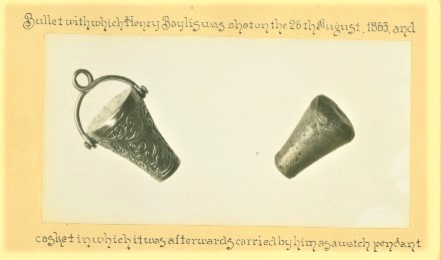
The Baylis bullet and its gold pendant case. Photo: Museum of the Riverina collection.
The offending bullet, recovered from inside his shirt, soon became Baylis’s lucky charm and a small engraved gold case was made for it by the grateful citizens of Wagga.
He wore it on a fob chain for the rest of his life.
Sadly, the case was stolen some years ago, but Baylis’s lucky slug remains at the museum.
It’s an unusual projectile, unlike the lead balls commonly used at the time. It is almost 30 mm long, tapered and flattened at each end.
The widest end of the projectile is about 18 mm, suggesting that it was most likely fired from a 12-gauge shotgun as a single slug, wide end forward.
Henry Baylis was indeed lucky to survive!

The bullet was most likely fired from a 12-gauge shotgun. Photo: Chris Roe.
The bullet and the gold bushranger medal awarded to Baylis in 1875 by the government, for his ”gallant and faithful service”, are held in the Museum of the Riverina’s permanent collection.







